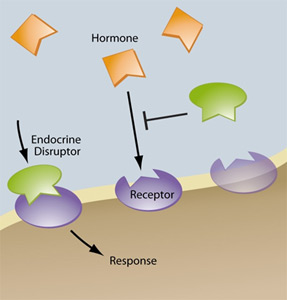Hormones
Avoid Hormones with PLD
Hormones, birth control pills, caffeine, estrogen, estrogen disruptors, false estrogen, bleach, chemicals, soy, flaxseed, fish oil, oily fish, yeast, alcohol, sugars, pesticides, herbicides, dry cleaning solutions, methylparabens, metaloestrogens, phthalates, xenoestrogens all expand liver cysts. Environmental endocrine disruptors, xenoestrogens, contribute to decreased sperm counts, sterility, and reproductive tumors.Why no hormones?
Cholangiocytes
Firstly we have to establish that PLD or Polycystic Liver cysts generate only from Liver Cholangiocytes cells and not liver hepatocyte cells. The liver has cholangiocytes and hepatocytes. Cholangiocytes makes up only 3% of liver cells yet cholangiocytes produce 40% of the bile. Cholangiocytes is the only type of liver cell that can become a cyst. Liver cystic epithelium can be regulated by estrogens. If we can slow down cholangiocyte damage, we slow down polycystic liver growth.Electron Microscope view of liver cyst walls
The Italians looked at liver cyst walls with an electron microscope. Through the electron microscope it was determined that within liver cyst walls there are hormone receptors; insulin receptors; growth hormone receptors all hormones can trigger liver cyst growth. All different types of hormones can trigger liver cyst growth. For this reason severe PLD'rs are urged not to take any hormones. Some cannot even use any creams, such as testosterone cream or prednisone creams, injections or steroids.
Cholangiociliopathies
Polycystic Liver Disease may be classified as cholangiociliopathies. In cystic cholangiocytes, over expression of ion transporters and water channels facilitates fluid secretion into the cystic lumen. Growth factors, estrogens and cytokines promote cholangiocyte proliferation. In other words, hormones cause liver cysts to fill with fluid and expand.Follicle stimulating hormone
Follicle-stimulating hormone causes an increase in cholangiocytes. Liver cysts are only formed from cholangiocytes. Liver cysts cannot be formed from other liver cells such as hepatocytes. Follicle stimulating hormone causes an increase in cholangiocytes, this increase in our cholangiocytes, can lead to the development of more liver cysts.Histamine
Cholangiocytes increase in response to histamine receptor stimulation. This is a reason to avoid the top 10 allergic foods. Cholangiocytes proliferate in response to H1 histamine receptor stimulation and liver cysts respond to this increase in cholangiocytes.The Top 10 Allergic Foods
Allergic foods are capable of raising blood pressure as well as releasing histamines. This release of histamines leads to an increase in liver cholangiocytes creating more liver cysts which can stem only from cholangiocyte cells.
Wheat
Soy
Shellfish
Fish
Tree Nuts
Peanut
Eggs
Milk
The above eight foods are the notorious big eight. They account for nearly 90% of food-related allergic reactions in the United States. Allergenic foods cause the release of histamine. Histamine release stimulates liver cyst growth. Rounding out the top ten food allergies are numbers nine and ten: sesame and celery.
Estrogens
estrogen
estrace
birth control pills
Premarin
PremPro
diethylstilbestrol
Estrogens stimulate the secretion of different growth factors in proliferating cholangiocytes. Estrogens and the pathophysiology of the biliary tree. False estrogens, xenoestrogens, endocrine disruptors are to be avoided. The body thinks their similar molecular structure is true estrogen. These endocrine disruptors are incorporated into the body as if they are true estrogen. Bisphenol A (BPA), initially designed, like diethylstilbestrol, is a synthetic estrogen. During the 1930's plastic was developed as an estrogen drug.
Estrogen Severe PLD
Only 8% of people with PLD will go on to develop severe PLD. At the Mayo following the first ten cases they had performed for a PLD liver resection, a follow up visit for this patient was the very first time Mayo doctors discovered that PLD was activated by hormones.
A woman with severe PLD wanted to wear a waisted dress for her wedding. She had a repeat MRI following her pregnancy birth. Her liver had grown. Researchers have long discovered that liver cysts have estrogen receptors within their cell walls.
Article
". . .estrogen can promote liver cyst growth via multiple mechanisms."
Article
". . .risk of having massive polycystic liver disease is related to female gender,
pregnancy, and exposure to exogenous sources of female steroid hormones such as contraceptive
steroids or use of female hormone replacement therapy by postmenopausal women."
76% of individuals with ADPLD have the second hit present. For PLD individuals the second hit is
active and plays an important role in liver cyst growth. It is for this reason that among the items
to be avoided include exposure to hormone disruptors such as bleach, pesticides, herbicides,
chemicals xenoestrogens.
Article
"Indeed, 1 year of estrogen use in postmenopausal ADPKD patients selectively increases total liver volume by 7%,, whereas total kidney volume remains unaffected."
Article
"The number of pregnancies, increased age and severity of renal disease are considered additional risk factors for liver cyst growth in ADPKD."
Many doctors when they see a woman in her 30's with severe PLD recommend
she seek alternatives to pregnancy as the hormones of pregnancy can promote PLD liver growth.
Article
It sometimes happens that PLD patients while taking Somatostatin, hepatic cysts may get infected.
Hot flashes
As we approach menopause some women with PLD may be advised to take HRT. Try to avoid this. Hormones can cause liver cyst growth. For hot flash suggestions some have been successful using prescribed Effexor. For osteoporosis there are other suggestions. Other good news is with more and more women refusing hormone replacement therapy, breast cancer rate has declined. Researchers attribute this to lower hormonal replacement therapy rates.
What Makes Liver Cysts Grow?

Liver cysts have receptors within their cell walls. These following compounds are similar. They ↑ liver size and cyst growth attaching to hormone receptors within the liver cysts.
BPA
Bleach
Endocrine disruptors
Hormones
Parabens
Phytoestrogens
Phthalates
Plastic
Xenoestrogens